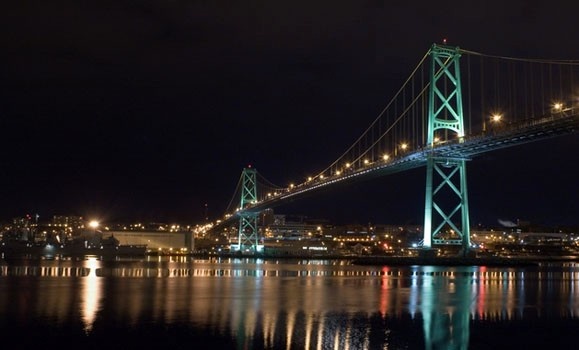The Halifax and Dartmouth communities are undergoing an unusual infrastructure change, and School of Public Administration Director Kevin Quigley is collaborating with international colleagues to study its socio-economic consequences.
In a project termed ‚ÄúThe Big Lift,‚Äù 2,500 feet of the Macdonald Bridge will be re-decked ‚Äî¬Ýreplaced piece by piece ‚Äî¬Ýover the course of approximately 18 months. Workers will complete the project through 10.5-hour shifts overnight from Sundays to Thursdays, as well as on several weekends. While the bridge will necessarily close during working times, it will be open during the day and most weekends.
Dr. Quigley, two students from the Master of Public Administration program and one MPA alumnus are collaborating with Calvin Burns at the University of Strathclyde in Glasgow to study The Big Lift. Dr. Quigley is part of a risk research group that includes scholars from different disciplines based at –¬º”∆¬¡˘∫œ≤ ø™Ω±÷±≤• and Strathclyde. For this project, Dr. Burns combines his knowledge of industrial-organizational psychology and his background studying how people perceive risk at the workplace with Dr. Quigley‚Äôs expertise in public sector risk management and critical infrastructure protection (CIP). Their project will use community feedback to gauge the effects, both anticipated and real, of The Big Lift.
Assessing the impact on key groups
“This is a big community event,” says Dr. Quigley, who explains that the direct and indirect effects of the bridge re-decking may be wider than imagined. He is interested in examining how the temporary bridge closures will affect different groups of HRM residents. He notes that critical infrastructure such as bridges is essential for the entire community, and that a project like this will affect everything from traffic and emergency services to workplaces and consumer behaviour.
Dr. Quigley and his research partners have been interviewing some of those who are likely to be affected by the night closures: owners, patrons and employees of small and medium-sized businesses who operate in the evenings, such as bars, restaurants and hotels.
“At this stage, people struggle to imagine what the impact of the bridge closure is going to be,” says Dr. Quigley.
As The Big Lift progresses, the research team will question the same groups on their lived experiences of the project. “We will be interested to learn how they gather information about the bridge closures, and if, when and why they adapt their behaviour,” Dr. Quigley says. The researchers are also speaking with larger organizations, such as hospitals and emergency services, to learn how other critical services are dealing with the bridge’s night closures.
A first-of-its-kind study
This is only the second time in history that a bridge has been re-decked through night closures. When Vancouver embarked on a similar project with the Lions Gate Bridge, however, there was no comparable study, making the Halifax research even more valuable.
“As far as I know, the broader social effects of this type of closure have never been studied,” says Dr. Quigley. “So we’re almost designing a method for planning this kind of infrastructure change in other cities, as well as documenting lessons for Halifax that it can apply when it re-decks the MacKay Bridge in a few years’ time.”
Dr. Quigley hopes and predicts that through The Big Lift and their study, “Halifax will learn how to be a more adaptive and smarter city. It may cause some inconvenience but it has to be done, and it’s a great learning opportunity for all of us.”
Read more about .

